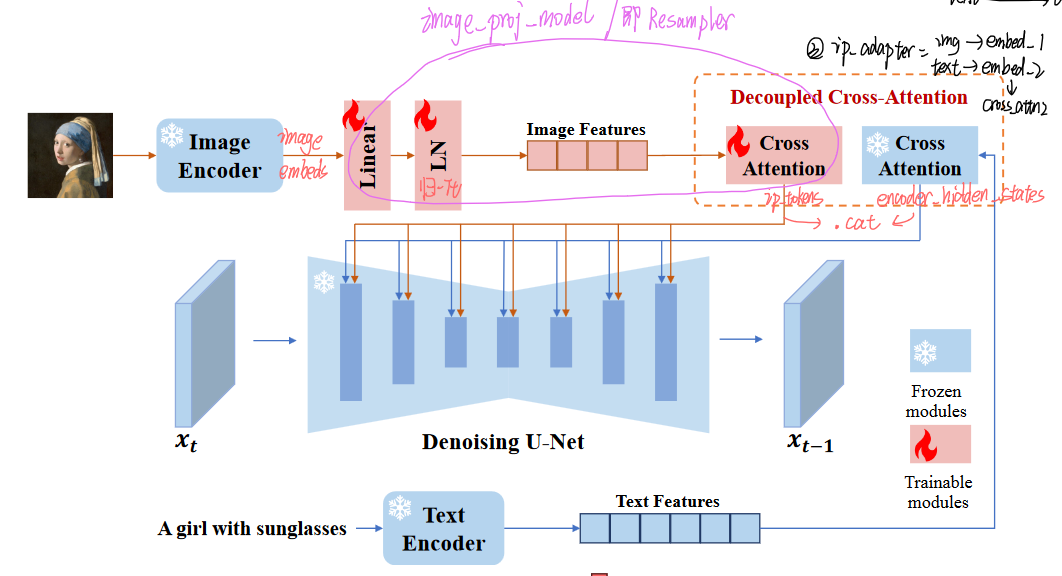Paper Reading:IDM-VTON:Improving Diffusion Models for Authentic Virtual Try-on in the Wild-2024 ECCV
IDM-VTON: Improving Diffusion Models for Authentic Virtual Try-on in the Wild (in 2024 ECCV)
论文概括:论文中提出了一种改进的扩散模型 (Improved Diffusion Models for Virtual Try-ON, 简称IDM–VTON),使其应用在真实世界场景下虚拟试穿任务。该模型显著提高了服装图像的一致性,可以生成真实的虚拟试穿图像。具体地,设计一个复杂的注意力模块(attention modules),可以将服装图像更好的编码到扩散模型,该注意力模块由两个不同的组件组成:
- 作用在self-attention——IP-Adapter:对图片形式的服装提示进行编码适配(image prompt adapter)【高级语义】
- 作用在cross-attention——GarmentNet:同样对服装图片进行编码,不过使用UNet的hidden_state直接得到特征,保留细粒度的细节【低层特征】
方法
IDM-VTON整个模型框架由三个部分组成:
- TryonNet:13通道的UNet,以常见的9通道InpaintingModel作为初始化+4通道的pose map latent
- IP-Adapter:提取服装高级语义**【代码中并没有训练?】**
- GarmentNet:基于UNet的特征编码器,提取服装的低级特征,直接使用冻结的SDXL-base

1. TryonNet 详解
TryonNet的输入由4个部分组成,共13通道=4+4+4+1:除了单通道的mask外,均为4个通道(VAE编码层获得latent是4通道):使用开源的9通道SDXL-Inpainting模型作为初始化,并使用卷积层来修改UNet的输入特征通道(卷积层初始化为0)。代码如下:
1 | |
2. IP-Adapter 详解
使用IP-Adapter对服装图像进行编码,使用冻结参数的CLIP图像编码器(即 OpenCLIP ViT-H/14)来提取特征。论文说IP-Adapter【包括特征投影层(feature projection layers)和交叉注意层(cross-attention layers)】是可训练的,但代码里并没有训练,社区的issues也提到了不训练可能会更好:ipa可能会影响到衣服颜色准确度*。

3. GarmentNet 详解
由于 CLIP 图像编码器缺乏提取服装的低级特征(CLIP训练的文本图像对比较广泛,对服装细节无法详细的描述),导致:虽然IP-Adapter已经引入了来自服装图像的控制,但当服装具有复杂的图案或印花时,IP-Adapter在保留服装的细粒度细节方面存在不足。而SDXL模型在大规模数据集上经过预训练,已经具备了良好的低级特征提取器的能力,可以作为对IPA的细粒度特征的补充特征。
具体实现可以理解为:来自两个UNet网络的低层次特征 (Low-level features) 先通过自注意力进行特征融合,再和来自IP-Adapter的高级语义(High-level semantics)通过交叉注意力进行特征融合
- 冻结SDXL-base的UNet网络参数,并获取其hidden state中间表示作为低级特征
- 与来自TryonNet的中间表达进行连接,然后计算连接特征的自注意力(Self Attention)
- 只传递来自TryonNet的前半部分特征,将其与IP-Adapter结果特征进行交叉注意力(Cross Attention)计算并继续传递
4. 使用更详细的Caption:对服装的细节进行精细描述
更详细的描述有助于模型使用自然语言对服装的高级语义进行编码,对基于图像的信息进行补充。[V],即 cloth_annotation 通过图像注释器(image annotator,对图片中的特定属性进行分类识别)获得。
1 | |
1 | |